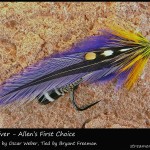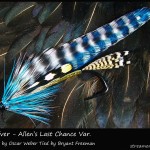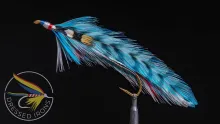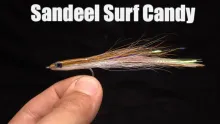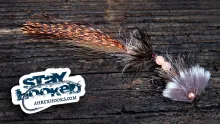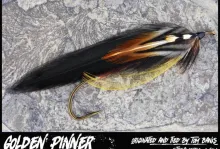Bryant's Streamers on Streamers 365
Bryant's Streamers
Bryant's Biography
Born in Greenfield Queens County, on the South Shore of Nova Scotia, on the banks of the Medway River, June 23rd 1941 The doctor who delivered him came from Liverpool, a distance of 20 miles, and was Salmon fishing with his father Lewis, when Bryant arrived, beginning his lifelong adventure in the fly fishing world.
He helped his father tie salmon flies at the age of five, his dad had lost his right arm in a sawmill accident and Bryant would hold the hair for the wings, on the Macintosh flies (Rags) which were popular on the river. his dad would wrap the thread around the butts of the hair, while Bryant held the hair, after this was done, the job could be finished by his Dad.
At the age of 10, Bryant caught his first Atlantic salmon while fishing alone, a 12 pounder, on a Silver Grey traditional (Feather wing). In those days a Silver Grey purchased at the Hardy Bros shop in England was the order of the day for wet flies, most fishermen on the river in those days preferred the traditional feather wings over the hair wing flies which are in present day fly boxes. Dry flies were the main attraction for Atlantic salmon on the Medway after May 24th, pine squirrel wings and peacock herl bodies, with a yellow, brown or white hackle would do the trick with most salmon.
At the age of 14 he became a Fishing guide on the Medway, working out of the Freeman House Hotel, catering to the sports from the eastern seaboard of the USA. After several years guiding with a regular clientele which booked him every year, he made enough money to help put him through telecommunications school in Saint John New Brunswick.
In 1956 Ted Janes, a writer for Field and Stream from the USA came to the Medway and wrote a story on Atlantic salmon fishing, this was carried in the True Fishing Yearbook 1957, the story was also published in the Atlantic Salmon Journal, and the following year, it was Published in the limited edition (1000 copies) by Colonel Joe Bates, The Atlantic Salmon Treasury.
Graduating from Vocational on Feb 1st 1960, he began working for C N Railway Telecommunications, on the road covering the hamlets of Northern New Brunswick. In the back of his car was a fishing rod, hip boots and flies he tied. He gained much experience fishing Atlantic salmon on the Miramichi during these years, hooking over 100 salmon most years. One fly in particular caught so many fish that the hook wore thin, this fly is one of his own makes, but without a name. until Paul Marriner wrote a book of fly patterns called Modern Atlantic Salmon Flies, In this Book the fly took on the name, "Rabbi".
He started tying the Traditionals (Classics) in 1967, obtaining the book he calls his fly tying bible, "The Fly Dressers Guide" by John Veniard. His materials came from Veniard's in England, or Herter's in Waseca Minn., in later years from local shops like Frank Rickard's Fly Shop in Riverview, WW Doak in Doaktown, John Hopey and P A Furlotte in Moncton. He still has some of the materials he obtained in those years, and checks them every once in awhile to see if the quality is remaining the same. One thing he notices is the move to genetic feathers, which in his estimation is striving for certain qualities in a feather, most times the originals and those untouched by genetics, prove to be more effective while fishing, while genetics look good to the human eye, they do not prove to be as good in fishing flies..
He left the fishing world for a period of ten years while pursuing the sport of golf, in 1975, realizing he could not do both, came back to fishing and remains there today. He comments, the fraternity is slowly dying with the advent of computers, organized sports, and competition, the art of fly fishing and tying is slowly making its way into history. Today most people who call themselves fly tyers, want to spin deer hair and make bugs which are effective for catching fish, they are not very appealing to the eye but are effective.
He tied flies for Frank Rickard and WW Doak and Sons, making feather wings for several years, then in 1985 he decided to try a little shop of his own, obtaining the materials and dyeing them, preparing them for his clients, till present time. The name of this shop is Eskape Anglers, he sells his flies and feathers world-wide.
Changes have taken place in the fly tying industry, the beginning of the great classic rush, when Poul Jorgensen wrote, his first book in the 1972, many fly tying enthusiasts began tying these dressed flies, making a demand on materials, which still today keep supplies at an all time low.
The Demand for the larger feathers has created pressure on species that provide the feathers, as most people wish to tie flies larger than 2/0. Leaving the smaller feathers on the market, which will tie the smaller flies. He ties all his fully dressed flies on a size 2 up to size 10, and if a special order comes in for larger flies, he limits production to 200 per year in the 6/0 to 1/0 range..
He retired from his day job February 1st 1991, has been tying flies, and preparing feathers ever since. Gaining international recognition in traditional feather production.
He has sold many flies at auctions, some frames are donated to the Miramichi Salmon Association and the Atlantic Salmon Federation or The Maine Public Television Network for their auctions for conservation purposes. There is a waiting list for his traditional classics.
He is a past Director of the New Brunswick Council of the Atlantic Salmon Federation Inc. A past president of the Nelson Hollow Salmon Association, Past Executive Secretary of the NB Council of the Atlantic Salmon Federation Inc., and past Secretary Treasurer of the Petitcodiac Riverkeeper, he was the chief Editor of the NBSC, Barbless Butterfly. In September 2007, he was inducted into the Miramichi Salmon Museum Atlantic Salmon Hall of Fame.
He is Self-taught in fly tying, (other than assisting his dad), he has picked up some valuable tips from Jerome Molloy and Scott Doncaster.
His motto is; do not tie the fly with too much hair or feathers, keep the size small, a good fly is one which has character and semblance, low wing and fishy looking. A fly which looks good in a fly box usually is just that, (looks good in a Fly Box). His favorite Traditional fly is the Silver Grey and his favorite fall fly is the General Practitioner, his all time favorite swings between the Carters Bug, Rabbi, and Brown Rags.
He has fished the Restigouche, Margaree, Bonaventure, Grand Cascapedia, Upsalquitch,and all the Miramichi Rivers, the Saint John, which he loved before they dammed it at Mactaquac. The Salmon River and the Petitcodiac river in his home town, The Kedgwick is also one of his favorite rivers. His home river, the Medway in Nova Scotia has been closed to salmon fishing for several years, due to stocks being low, the result of Acid Rain which falls on the area produced from industries in the eastern United States and central Canada. He returns there every year when the Atlantic Salmon run occurs just to be there and rejuvenate his desire to be close to nature and the salmon.
His plans for the future, is to keep going with some feather preparation, as there is still a Demand for specialized service and as long as he is able, Bryant will provide.
He loves dogs, hunted for many years, ducks being his favorite, but has laid down his guns due to government regulations.
Has lived with the same woman for 50 years this June, enjoying each others company, she has no interest in fishing He calls her "Sugar" a name which stuck from the TV series the Real McCoys of the 60's era. He is a Father of a son, who works for the City of Toronto, his Daughter is a Chef for the home for the aged in Boiestown, NB.
- Log in to post comments


